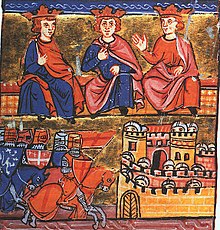Siege of Damascus (1148)
| date | July 23-28, 1148 |
|---|---|
| place | Damascus |
| output | Retreat of the crusaders |
| Parties to the conflict | |
|---|---|
| Commander | |
|
Unur , vizier of Damascus |
|
| Troop strength | |
| 50,000 | unknown |
| losses | |
|
unknown |
unknown |
The siege of Damascus by the crusaders of the Second Crusade under King Baldwin III. , Conrad III. and Louis VII took place from July 23-28, 1148 and ended with the retreat of the Crusaders.
prehistory
After a few defeats in Asia Minor , the army of the Second Crusade arrived in the Holy Land , where they united with the troops of the Crusader states . In Acre , the leader of the crusade, King Conrad III, stopped on June 24, 1148. and King Ludwig VII. with King Baldwin III. held a council from Jerusalem to discuss how to proceed. The actual aim of the crusade, to retake Edessa , which had fallen to Zengi in 1144 , had already been eliminated. After Count Joscelin II briefly recaptured the city after Zengi's death in 1146, Zengi's son Nur ad-Din had Edessa almost completely destroyed and depopulated. After a controversial discussion, it was finally agreed to besiege Damascus. In fact, Damascus was neutral towards the Crusaders and an enemy of Nur ad-Din and even paid tribute to the Crusaders. However, the city also appeared to be a worthwhile destination as it was wealthy and close, and did not have an overly strong military. Since a conquest of Damascus would cut off the Muslim empires of Asia from those in Africa , it was also a strategically interesting target.
siege

In mid-July 1148, the largest army that the Crusaders had ever raised in the Orient gathered in Tiberias . With the Holy Cross in the lead, the army marched first to Banyas and reached Damascus on July 23. The vizier Unur , who ruled there on behalf of the underage Emir Mujir ad-Din Abaq , sent a messenger to Aleppo to ask Nur ad-Din for help. While the first auxiliary troops from Unur's provincial governors arrived, the crusaders had already stormed the lightly fortified orchards to the west of the gates. The crusaders decided to set up camp in these same orchards, which for them had the advantage that water and food were just as readily available as lumber for siege equipment. However, the confusing trenches and bushes made the crusaders vulnerable to ambushes and smaller raids. Since Unur feared that Nur ad-Din wanted to seize Damascus, he first tried to repel the crusaders with his own troops. The crusaders were pushed from the walls of Damascus back into the orchards by a violent counterattack by Unur, where they were repeatedly attacked by the light units of Unur, so that they finally decided to move their camp to the more manageable level in front of the city. At the same time, Unur negotiated with the leadership of the crusade and offered money. There was also a dispute among the crusader princes about who should rule Damascus after the conquest. When it became known that Nur ad-Din's army was advancing from Homs, the siege was finally called off after only five days.
consequences
The Second Crusade ended in complete failure. The crusader princes blamed each other for the failure of the siege. Conrad III. moved with his army to Ashkelon to conquer this city from the Egyptian Fatimids . Like Damascus, the conquest of Askalon could have cut off the Muslim empires of Asia from those in Africa . Due to the prevailing distrust, however, neither the French nor the Crusader states followed him; and because of the heavy losses suffered while crossing Asia Minor, his German contingent was not strong enough to take up the siege alone. So the crusaders returned to Europe without having achieved anything.
Damascus no longer trusted the crusaders either and later submitted to Nur ad-Din. This came one step closer to the goal of uniting Muslims and driving the Crusaders out of the Holy Land.
The Muslim view of the event
The Muslim sources point out that two prominent members of the Damascus religious class, the Maliki jurist Yūsuf al-Findalāwī and the ascetic ʿAbd ar-Rahmān al-Halhūlī, both of old age, were martyred during the siege of the city . Al-Findalāwī is said to have justified his commitment to the defense of the city with the words: “I have sold and He has bought from me. By God, I neither dissolve the contract, nor do I ask for a solution. "With this he was referring to the Qur'anic word in Sura 9: 111, which is important for jihad mobilization :" God bought their person and property from the believers for them should have paradise. Now for God's sake they have to fight and kill and suffer death themselves. "
literature
- Reinhard Barth, Uwe Birnstein , Ralph Ludwig, Michael Solka: The Chronicle of the Crusades . Chronik Verlag, Gütersloh / Munich 2003, ISBN 3-577-14609-5 .
-
Francesco Gabrieli (Ed.): Storici arabi delle Crociate (Nuova universale Einaudi; Vol. 34). Einaudi, Turin 1969.
- German: The Crusades from an Arab perspective . Bechtermünz Verlag, Augsburg 1999, ISBN 3-8289-0371-1 , pp. 98-105 (EA Zurich 1973).
Individual evidence
- ↑ KM Setton (ed.) / MW Baldwin: A History of the Crusades. The first hundred years . University of Wisconsin Press, Madison 1969, p. 507.
- ↑ KM Setton (ed.) / MW Baldwin: A History of the Crusades. The first hundred years . University of Wisconsin Press, Madison 1969, pp. 507f.
- ↑ Cf. Gabrieli 102f.

